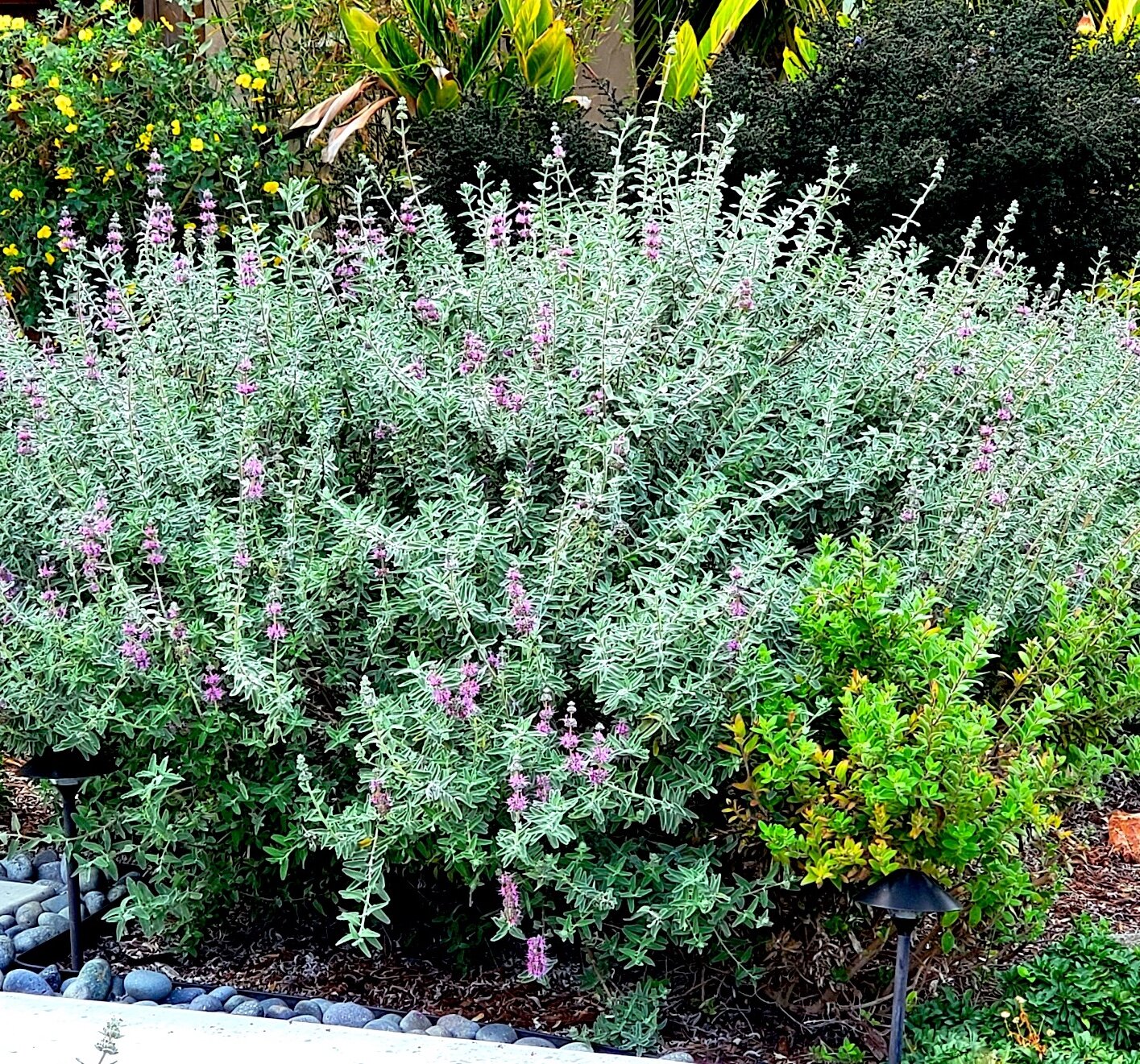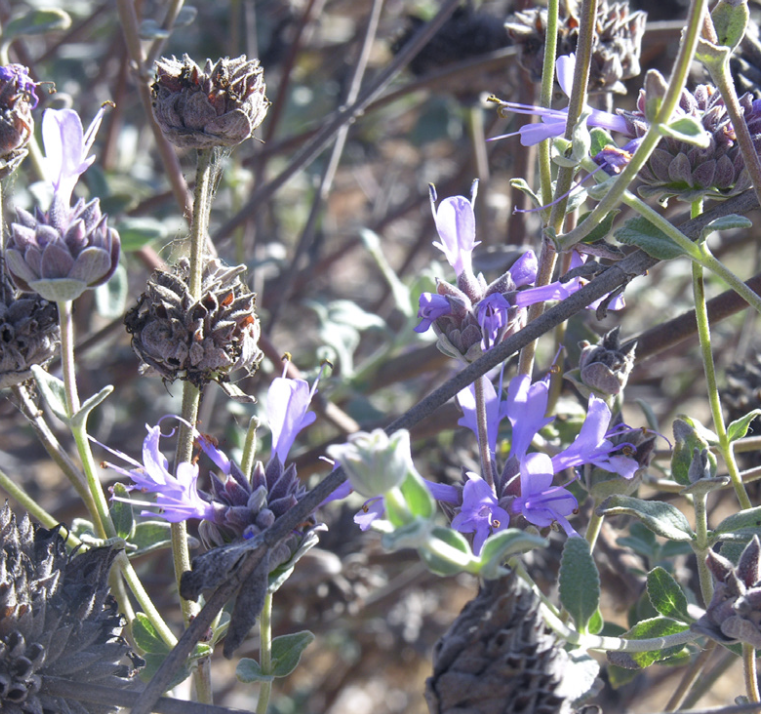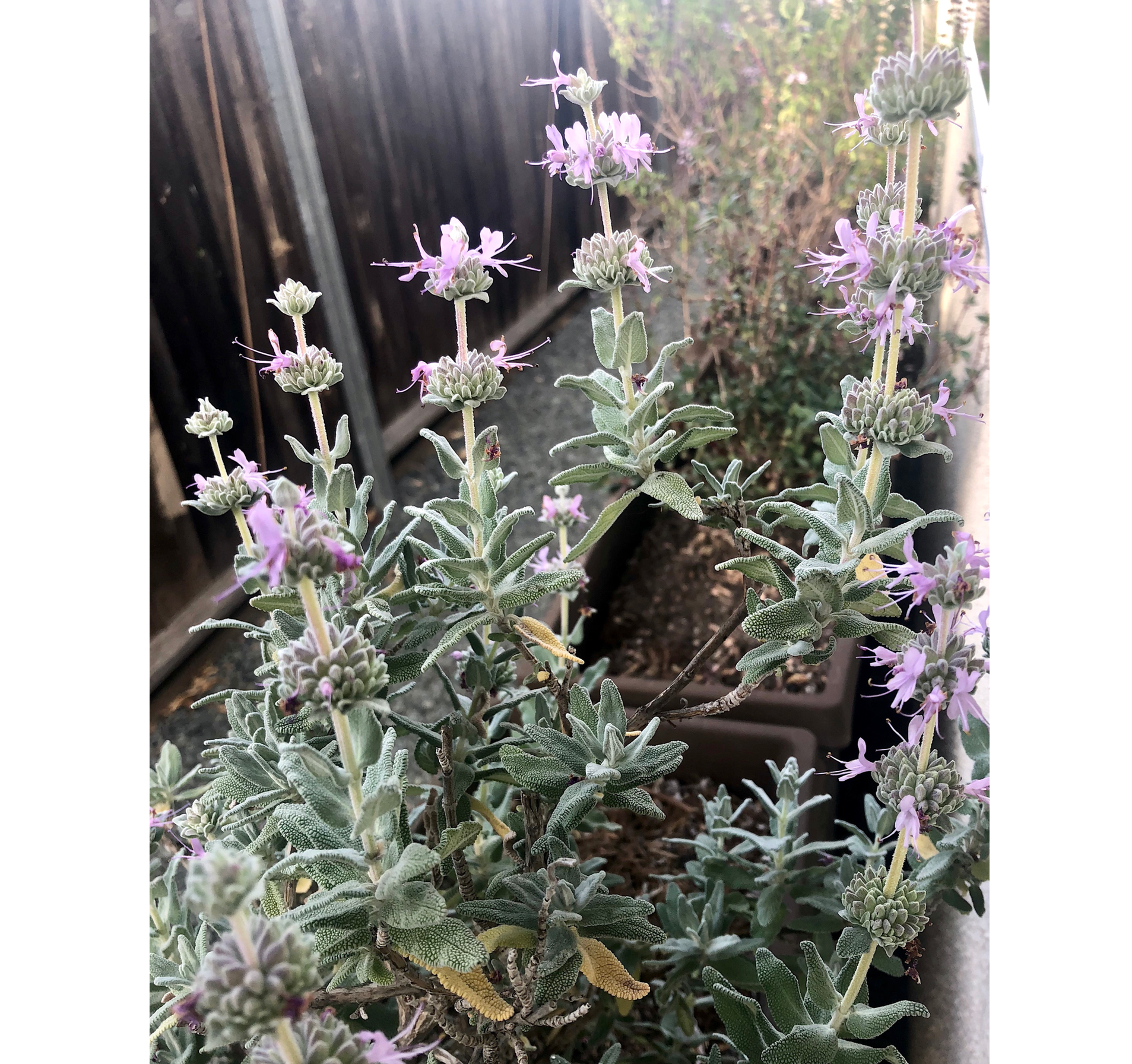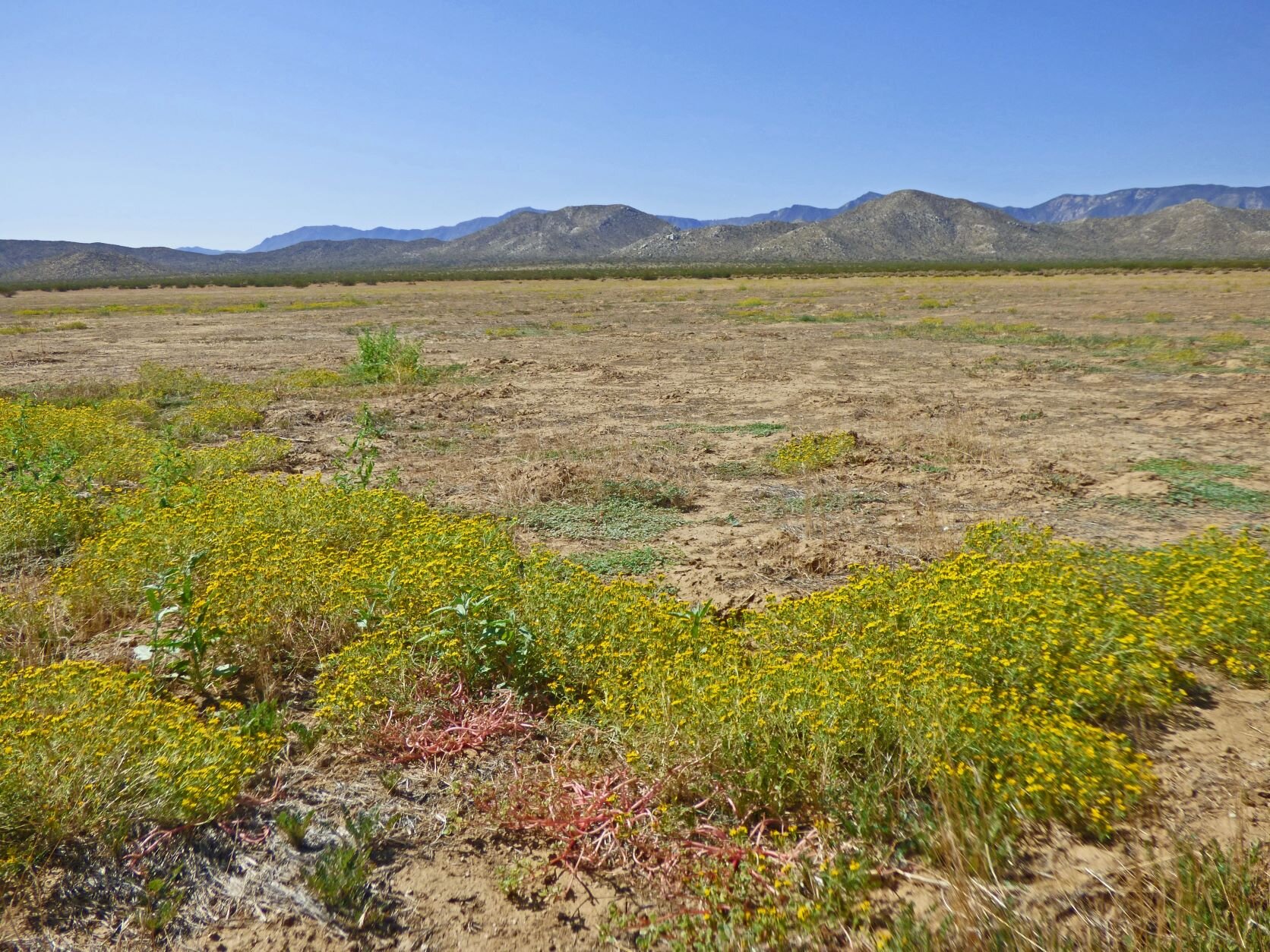

![Salvia munzii © Dick Culbert [CC BY 2.0]](https://images.squarespace-cdn.com/content/v1/585dc42c725e25ca57806ffc/1612122771948-8O3BLTFJZQY540II2JO4/Salvia+munzii+%C2%A9+Dick+Culbert+%5BCC+BY+2.0%5D+copy.png)
![Salvia leucophylla © John Rusk [CC BY 2.0]](https://images.squarespace-cdn.com/content/v1/585dc42c725e25ca57806ffc/1612122626980-1YA23E40EGSL6G9GOPK5/Salvia+leucophylla+%C2%A9+John+Rusk+%5BCC+BY+2.0%5D+copy.jpg)


![Salvia pachyphylla © Dick Culbert [CC BY 2.0]](https://images.squarespace-cdn.com/content/v1/585dc42c725e25ca57806ffc/1612122631990-TWYFBJE1EE930WT0RI99/Salvia+pachyphylla+%C2%A9+Dick+Culbert+%5BCC+BY+2.0%5D+copy.jpg)
By Teresa Everett, California Native Plant Garden Educator
If you have been on any of our CNPS native garden tours or have hiked through our local hills, mesas, or valleys, you have no doubt seen (and smelled) California’s magnificent blooming sages. If you have visited any nurseries, you have also noticed the wide variety of sages on the display tables—so many, in fact, that it can be overwhelming. How do you choose which sage is best for your garden? The following is a quick primer on the sages of California. California is home to 17 of the world’s 800-plus sage species. Because several of our California species will naturally hybridize, horticulturalists have used this reproductive malleability to create dozens of cultivars and hybrids for garden use. These horticultural varieties range from 7-foot-tall shrubs to ground-hugging forms only a few inches high. The silvers, grays, and greens of their foliage, plus the long-running show of flowers that come in a spectrum from white to pink to mauve to scarlet to purple to indigo to sky blue, make the California sages a must-have in your garden palette.
California sages are lovers of dry areas and thus thrive in low-water landscapes. They are found along our coasts, across our inland valleys, up into the Sierra Nevada foothills, and out into parts of our deserts. Most sages tolerate clay soils very well, the exceptions being the desert species. The vast majority of sages thrive in full sun, but there is a species, the hummingbird sage (Salvia spathacea), that will light up the shadiest section of your garden with beautiful hot pink flower spikes. Sages do very wel lin some of a garden’s most difficult areas, such as dry, sunny slopes or rocky, clay soil.
All sage species are in the mint family (Lamiaceae). The scientific name of the sage genus, Salvia, is based on the Latinword meaning “to heal” or “to save.” Sages are treasured by cultures worldwide for their medicinal and culinary uses. The common culinary sage seen in grocery stores is the Mediterranean species, Salvia officinalis, but all of our California sages can be used in cooking as well. Each species has its own flavor profile, with some much stronger than others. Most people like to cook with either black sage (Salvia mellifera) or Cleveland sage (Salvia clevelandii). The mild hummingbird sage adds a delicate sweetness to food or drink recipes. White sage (Salvia apiana) has been quite important in indigenous Californians’ blessing and cleansing ceremonies. California’s native peoples have also made tea from sage leaves to cure illness and have toasted and ground seeds to make gruel. The“rediscovery” of the health benefits of chia (Salvia columbariae) seed has led to a recent resurgence in the popularity of incorporating this seed into a well-balanced diet. Honey harvested from beehives situated near areas covered with white, black, or purple sage is particularly delicate and flavorful.
Sages are also a very important food source for California wildlife. Sages bloom from late winter until late spring and into the summer, depending on the species. The flowers contain high-quality nectar and therefore are absolute magnets for hummingbirds, butterflies, bees, and other pollinators. After the blossoms set seed, they are also a feast for seed-loving birds, such as goldfinches, quail, sparrows, juncos, and towhees. Just remember to not deadhead all of the dried flower stalks so the birds can eat their share of seed! While sages are very attractive to birds and insects, deer and rabbits fortunately find them unappealing; the pungent odor of the leaves, which we and the birds and bees find so inviting, acts as a repellent to mammalian browsers.
In the garden, sages prefer full sun and good drainage, although hummingbird sage prefers partial to full shade. When first establishing your sages, you will need to water them every 7 to 14 days throughout their first year or so, to keep their root ball slightly moist but not wet or soggy. Once they are established (having doubled in size), you will need to ease back their watering to about once a month. If you are growing straight species, use the drier side of these suggestions and give them a break from watering in July, August, and September. The hybrids and cultivars have been developed for more refined garden tastes, and established plants can tolerate a watering every 2 to 4 weeks to keep them looking fresh. Also give the hybrids and cultivars a summer break, with sparser watering in the dormant months. Sages do not appreciate any fertilizers or soil amendments; they like our native soils just the way they are and rely on their relationship with the fungal friends on their roots and in our soils to extract all of the nutrients they require.
When researching varieties to use in your garden, pay close attention to mature size, as you should not prune more than one-third of your plant back at a time. Dead-heading sages after they flower will keep them looking neat but generally does not encourage a re-bloom. They can also be tip-pruned to keep them dense and pruned around the perimeter to limit their spread. Pruning back the plant by one-third in the plant’s quiettime (late summer) before they start pushing new growth in the fall works quite nicely as long as you do not cut into the thicker, woodier stems. Sometimes you can prune back almost 50% of the plant if it has exuberant growth from the previous spring. If you have a many-year-old sage with a nice, established root system, but it looks like it could do with a complete makeover or be replaced with a younger, denser plant, you can try a makeover first by cutting it back to just 6 to 10 inches off the ground and letting it re-sprout. One of my favorite blogs—Weeding Wild Suburbia—has nice articles on pruning young sages and pruning older sages to learn more.
So, now that you’re ready to plant some sage, how do you select which ones to bring home from the nursery? Here is a quick rundown of some favorite sages that you will find in nurseries, along with links to plant descriptions.
But first some quick definitions:
Straight species: those found naturally growing in the wild.
Horticultural selections: naturally occurring variation of individual plants within a species that are brought into cultivation.
Hybrid: a natural or cultivated cross between two or more species.
STRAIGHT SPECIES AND THEIR HORTICULTURAL SELECTIONS
WHITE SAGE
White Sage (Salvia apiana)
Beautiful silver-blue foliage, white flowers on tall flower stalks. Local to San Diego County
4′-8′ high, 6′ wide
Compact White Sage (Salvia apiana var. compacta)
3′ high, 3′ wide
Smaller, more compact form that fits well into a home garden
BLACK SAGE
Our most common salvia in the coastal sage shrub community. Highly aromatic and shiny dark green leaves and very pale blue flowers.
Black Sage (Salvia mellifera) Local to San Diego County
5′ high, 5′ wide
Light blue to white flowers
Terra Seca Black Sage (Salvia mellifera ‘Terra Seca’)
1′ high, 6′ wide
White flowers
Jade Carpet Black Sage (Salvia mellifera ‘Jade Carpet’)
1′ high, 5′ wide
Lavender flowers
PURPLE SAGE
Fuzzy gray-green leaves with light purple to lavender flowers. All are excellent on slopes.
Purple Sage (Salvia leucophylla) - Local to San Diego County.
5′ high, 7′ wide
Light pink to lavender flowers
Amethyst Bluff Purple Sage (Salvia leucophylla ‘Amethyst Bluff’)
• 10′ high, 15′ wide
• Lavender flowers
Figueroa Purple Sage (Salvia leucophylla ‘Figueroa’’)
• 4′ high, 6′ wide
• Lavender to pink flowers
Point Sal Purple Sage (Salvia leucophylla ‘Point Sal’)
• 2′ tall, 8′ wide
• Pinkish purple flowers
CLEVELAND SAGE
Most aromatic of all the sages. Gray-green leaves with newer growth having reddish stems. Lilac-blue to blue-violet flowers.
Cleveland Sage (Salvia clevelandii) - local to San Diego County
• 4′-5′ high, 5′-6′ wide
• Light purple to lavender flowers
Aromas Sage (Salvia clevelandii ‘Aromas’)
• 4′ high, 4′ wide
• Lavender flowers
• Highly aromatic
Winnifred Gilman Cleveland Sage (Salvia clevelandii ‘Winnifred Gilman’)
• 3′ high, 3′ wide
• Electric bluish-purple flowers
Alpine Cleveland Sage (Salvia clevelandii ‘Alpine’)
• 3′ high, 5′ wide
• Blue flowers
SAN MIGUEL MOUNTAIN OR MUNZ’S SAGE
Small, rare sage found only in south San Diego County. Petite dark green leaves and pretty blue flowers. Looks dainty but is as tough as nails. Good on slopes.
San Miguel Mountain Sage (Salvia munzii) - local to San Diego County
• 3′ high, 3′ wide
• Crystal blue flowers
Emerald Cascade Munz’s Sage (Salvia munzii ‘Emerald Cascade’)
• 1′-2′ high, 2′-3′ wide
• Blue flowers
CREEPING SAGE
Flat, spreading sage found on dry slopes in the understory of larger chaparral shrubs, oaks, pines, or other trees. Does best with some light shade. Gray-green foliage.
Creeping Sage (Salvia sonomensis) - local to San Diego County
• 1′ high, 5′ wide
• Periwinkle blue to almost white flowers
HUMMINGBIRD SAGE
Shade lover that will slowly spread to form a colony.Large arrow-shaped leaves are fuzzy and have a wonderful fruity smell. Flowers appear on stalks that rise up well beyond the foliage. A perfect plant for the dry shade conditions under oaks.
Hummingbird Sage (Salvia spathacea) - local to northern coastal San Diego County
• 1′ high, 3′ wide
• Magenta flowers
Powerline Pink or Giant Hummingbird Sage (Salvia spathacea ‘Powerline Pink’)
• 3′ high, 6′ wide
• Dark pink flowers
THE DESERT SAGES
The desert sages of California are very tough and can take extreme drought, heat, and freezing temperatures. Their feet, however, cannot handle anything but well-drained soils.
Desert Purple Sage (Salvia dorrii)
• 3′ high, 3′ wide
• Deep blue flowers
Mojave Sage (Salvia mohavensis)
• 2′-3′ high, 2′-3′ wide
• Sky blue flowers
Mountain Desert Sage (Salvia pachyphylla) - local to San Diego County
• 2′ high, 3′ wide
• Two-toned deep rose and blue flowers
HYBRIDS
GROUNDCOVERS
Bee’s Bliss Sage (Salvia ‘Bee’s Bliss’)
• 1′-2′ high, 6′ wide
• Lavender-pink flowers
• Cross of Cleveland Sage and Purple Sage (S. clevelandiix S.leucophylla)
Dara’s Choice Sage (Salvia ‘Dara’s Choice’)
• 1′-2′ high, 4′ wide
• Lavender flowers
• Cross of Black Sage and Creeping Sage (S. melliferax S.sonomensis)
Rubin’s Baby Sage (Salvia ‘Rubin’s Baby’)
• 1′high, 3′ wide
• Lavender flowers
• More compact than Dara’s Choice
• Cross of Black Sage and Creeping Sage (S. melliferax S. sonomensis)
Gracias Sage (Salvia ‘Gracias’)
• 1′ high, 6′ wide
• Lavender flowers
• Cross of Cleveland Sage and Creeping Sage (S. clevelandiix S. sonomensis)
SUB-SHRUBS
Allen Chickering Sage (Salvia ‘Allen Chickering’)
• 5′-6′ high, 5′-6′ wide
• Lavender flowers, gray-green foliage
• Prolific bloomer
• Cross of Cleveland Sage and Purple Sage (S. clevelandiix S. leucophylla)
Whirly Blue Sage (Salvia ‘Whirly Blue’)
• 5′ high, 5′ wide
• Large, deep violet flowers
• Flowers are larger and a deeper shade of purple than Aromas and Allen Chickering
• Cross of Cleveland Sage and Purple Sage (S. clevelandiix S. leucophylla)
Pozo Blue Sage (Salvia ‘Pozo Blue’)
• 4′ high, 4′ wide
• Violet-blue flowers
• One of the most adaptable of sages
• Cross of Cleveland Sage and Purple Sage (S. clevelandiix S. leucophylla)
Celestial Blue Sage (Salvia ‘Celestial Blue’)
• 4′-5′ high, 4′-5′ wide
• Two-toned intense blue and pink flowers
• Cross of Cleveland Sage and Mountain Desert Sage (S. clevelandiix S. pachyphylla)
Calamity Jane Mounding Sage (Salvia ‘Calamity Jane’)
• 3′ high, 4′ wide
• Light blue flowers
• Cross of Black Sage and Purple Sage (S. melliferax S. leucophylla)
Hybrid Desert Sage (Salvia mohavensis hybrid)
• 3′ high, 3′ wide
• Cobalt blue flowers
• Cross of Desert Purple Sage, Mojave Sage, and Cleveland Sage (S. dorriix S. mohavensisx S. clevelandii)
Vicki Romo Sage (Salvia ‘Vicki Romo’)
• 3′ high, 3′ wide
• Light lavender flowers
• Cross of White Sage and Cleveland Sage (S. apianax S. clevelandii)
As you can see, there is a salvia for every gardener’s taste and every garden condition in a water-wise landscape. Take this list along with you when you next visit a nursery or CNPS plant sale to select the right sage for your garden. Then plant, water, and wait for the birds and pollinators to arrive!
Teresa Everett is a native garden educator and native plant enthusiast. She has been a CNPS member since 2012, a member of the Gardening Committee and her home was on the CNPS-SD 2018 Garden Tour. Teresa has worked for Moosa Creek as a retail sales and gardening specialist and wrote for their blog “Creekside Chat” until 2018. She has also given many presentations on native gardening at nurseries, gardening clubs and conservation organizations.





